

<< Go Back up to Region ‘Washington DC’
| Follow Mike Hume’s Historic Theatre Photography: |  |
 |
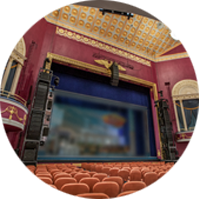
Architect: John Eberson (1948 remodel, in conjunction with son Drew Eberson)
First Opened: 7th December 1835 (190 years ago)
Former Names: National Hall, Fanny Morant’s National Theatre, Grover’s National Theatre, the New National.
Websites: www.thenationaldc.com  www.nationaltheatre.org
www.nationaltheatre.org 
Telephone: (202) 628-6161 
Address: 1321 Pennsylvania Ave NW, Washington, DC 20004 
The National Theatre is located just a few blocks east of the White House and is the second oldest continually operating theatre in the United States, having opened in December 1835. The original brick stagehouse and stone foundations still survive, however the auditorium has undergone multiple rebuilds and renovations during its 180-year history.

 Detailed Information
Detailed InformationIn 1830s Washington DC, William Corcoran and a group of other prominent citizens petitioned for the nation’s new capitol to have its own first-rate theatre. Subscriptions were sold and a suitable site identified three blocks east of the White House. A notice in the National Intelligencer of August 1834 requested bids for building of the new theatre, laying-out various measurements, terms, and conditional features of the building’s plans. The stage was to be timbered “sufficiently strong to sustain the pressure arising from the introduction of horses”, and the Orchestra (main floor) seating was to be removable “so that the building may be used as an amphitheatre”.
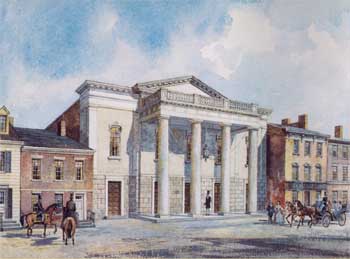
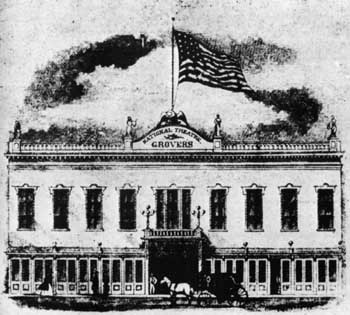
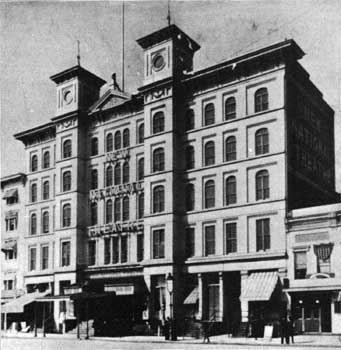
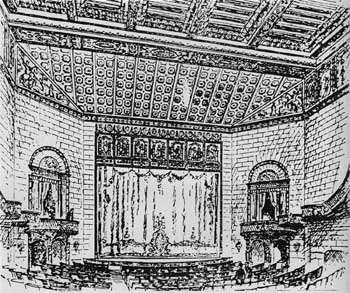
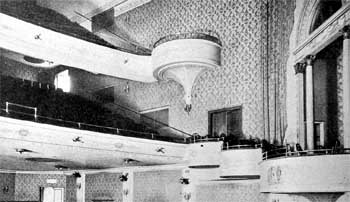
The Present
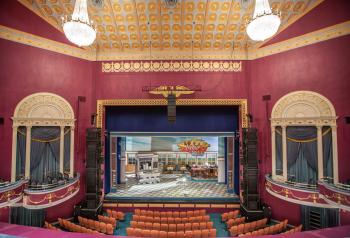
Following expiration of the lease in 1952, Broadway producers Robert Dowling and Richard Myers gained control of the National and reopened it as an integrated legitimate theatre with a production of Call Me Madam starring Ethel Merman. The theatre would go on to be managed for a time by the Nederlander Organization.
The theatre received a bit a makeover in 1956 when the rather “drab” house curtain was replaced with a pale yellow damask pattern to match the refreshed auditorium walls. It was at this time that the theatre’s signature hand-carved eagle was installed above the proscenium, replacing a previous pastoral mural.
The Nederlander Organization took over the theatre in 1972 with a 22-year lease, however the National fell on hard times due to the effects of race riots, the general population exodus from downtown to the suburbs, and the emergence of the Kennedy Center as a major performing arts center. Jimmy Nederlander tabled an idea with Roger L. Stevens, a longtime friend and Chair of the Kennedy Center, that a non-profit organization could manage the National while the Kennedy Center held the lease. The concept fell outside of the Kennedy Center’s remit however in 1974 Stevens came together with other interested parties to establish the not-for-profit New National Theatre Corporation to manage the National.
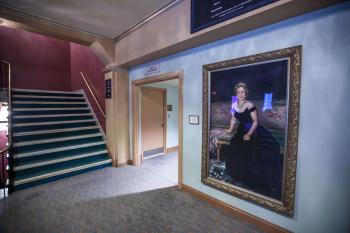
In 1974 renovations took place including new seating, a new cerulean blue and gold color scheme for the walls and ceiling of the auditorium, and gilding to highlight architectural features. A new, modular, stage flooring system was installed to replace the existing stage floor, which was in a sorry state having had many traps sunk into it over the years. Most significantly, the nation’s official portrait of Helen Hayes, by Furman Finck, was hung in the second floor lobby.
Washington in the mid-1970s was ripe for redevelopment, however the National managed to cling onto its plot of land – and most of its façade – while a large multi-use complex ascended on three sides taking up the rest of the city block.
Under the New National Theatre Corporation the theatre still under-performed, and in 1979 concerns were raised about Stevens’ management with accusations that he had embezzled funds, and he was ultimately shown the door. Later in 1979 the corporation terminated the Nederlander Organization’s lease and put management of the theatre out to tender. The Nederlander Organization was of course interested in taking back control of the theatre, however their ongoing association with Stevens saw them eliminated from the race at an early stage. Ultimately, the enormous booking power and financial stability of the Shubert Organization won through, and in 1980 they assumed management and programming of the National.
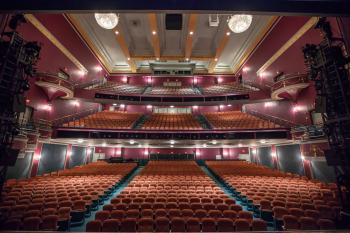
Initiated by concerns over land stability due to building work on several sides of the theatre, the National shut in Spring 1982. An 18-month $6 million major restoration was undertaken according to the plans of theatre designer, and now theatre architect, Oliver Smith. New HVAC systems were installed, a five-story backstage building constructed with spacious dressing rooms and a small rehearsal hall, the entrance lobby was expanded to three times its previous size, the auditorium’s chandeliers were commissioned, and a new public space was created called the Helen Hayes Gallery by removing offices at the mezzanine level.
The National Theatre reopened with a performance of 42nd Street in January 1984. President Ronald Reagan attended with his wife and saluted the refurbished “neighborhood theatre” in a speech delivered from the stage. Having undertaken perhaps more than it had originally bargained for, the National Theatre Corporation dropped “New” from its name.
In 2012 Chicago-based Jam Theatricals assumed management and programming of the theatre, expanding the National’s operations to include concerts, lectures, opera, ballet, seminars, and receptions, and introducing a new subscription series called “Broadway at the National”. In addition to the world premieres of If/Then and Mean Girls, recent theatrical presentations include Blithe Spirit starring Angela Lansbury, Jersey Boys, Les Misérables and the D.C. premieres of Motown the Musical, American Idiot, Fun Home, Something Rotten!, Waitress, and Newsies.
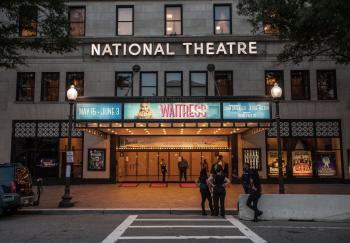
The theatre recently hosted the pre-Broadway world premiere of new musical Beetlejuice in October 2018. In addition, the National has recently presented many special events and concerts, including Kacey Musgraves, Dave Koz, Bryan Adams, Bill Burr, Eddie Izzard, Savion Glover, The Irish Tenors, and ThePianoGuys.
In late 2019 it was announced that the Nederlander Organization was joining forces with Jam Theatricals to create a new entity called Nederlander National Markets, and accordingly the Nederlander Organization will manage and operate the National Theatre once again.
The National has long been known as one of the leading pre-Broadway theatres, with Show Boat, Hello Dolly!, West Side Story, and most recently Beetlejuice among the many shows that have hit the National stage prior to New York. Tradition sees productions paint a show poster backstage on the stagehouse walls, signed by many of the cast.
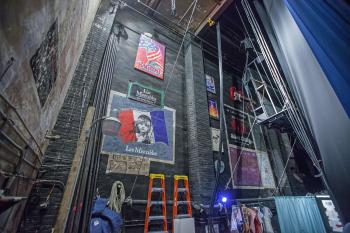
The National was a “hemp house”, using ropes and sandbags to manually move scenery, until September 2017 when a counterweight flying system was installed.
Every US President since 1835 has attended the theatre with the exception of President Eisenhower who attended while he was a General, and Presidents Obama and Trump.
Famous performers at the National have included Ethel Barrymore, Warren Beatty, Sarah Bernhardt, John Wilkes Booth, Fanny Brice, Carol Channing, Tim Curry, John Gielgud, Rex Harrison, Helen Hayes, Audrey Hepburn, Katharine Hepburn, James Earl Jones, Ertha Kitt, Alfred Lunt Fontanne, Ian McKellen, Ethel Mermen, Laurence Olivier, Annie Oakley, Debbie Reynolds, Chita Rivera, Will Rogers, and Sting. Winston Churchill also delivered a speech from the stage.
 How do I visit the National Theatre?
How do I visit the National Theatre?As of mid-2018 the National does not offer tours, so check the theatre’s website  for a calendar of events and online booking.
for a calendar of events and online booking.
 Further Reading
Further Reading contains both summary and detailed history of the National and performances at the theatre, in addition to some historic photographs.
contains both summary and detailed history of the National and performances at the theatre, in addition to some historic photographs. which contains a brief history and multiple historic photographs.
which contains a brief history and multiple historic photographs.
 , published in 1885, held at the Library of Congress, and scanned/published online by the Internet Archive.
, published in 1885, held at the Library of Congress, and scanned/published online by the Internet Archive. by iWeiss Theatrical Solutions.
by iWeiss Theatrical Solutions. from the Americans at Work film series.
from the Americans at Work film series. , by Douglas Bennett Lee, published by the University Press of America, Inc. ISBN 0819150215.
, by Douglas Bennett Lee, published by the University Press of America, Inc. ISBN 0819150215. , by Charles H. Day and edited by William L. Slout, published by The Borgo Press. ISBN 0809513072.
, by Charles H. Day and edited by William L. Slout, published by The Borgo Press. ISBN 0809513072. Technical Information
Technical Information Photos of the National Theatre
Photos of the National TheatrePhotographs copyright © 2002-2026 Mike Hume / Historic Theatre Photos unless otherwise noted.
Text copyright © 2017-2026 Mike Hume / Historic Theatre Photos.
For photograph licensing and/or re-use contact us here  . See our Sharing Guidelines here
. See our Sharing Guidelines here  .
.
| Follow Mike Hume’s Historic Theatre Photography: |  |
 |